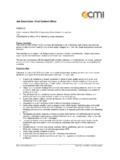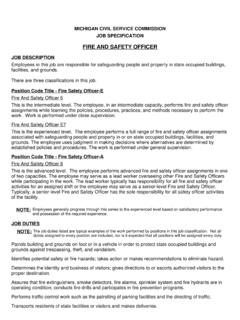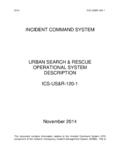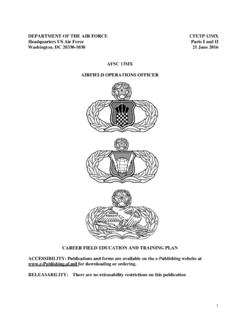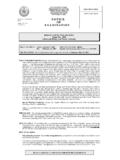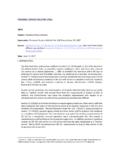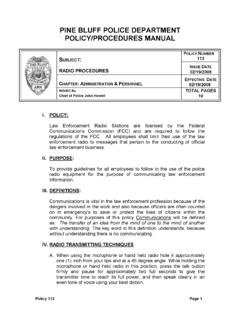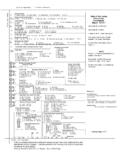Transcription of ICS POSITION DESCRIPTIONS AND …
1 INCIDENT COMMAND SYSTEM Canadian Version CANADIAN NATIONAL TRAINING CURRICULUM ICS POSITION DESCRIPTIONS AND responsibilities December 2003 2 INCIDENT COMMAND SYSTEM Canadian Version ICS POSITION DESCRIPTIONS AND responsibilities Prepared by Canadian Interagency Forest Fire Centre Resource Management Working Group Based on ICS POSITION DESCRIPTIONS and responsibilities 1994 PMS 203 NFES 2433 National Wildfire Co-ordinating Group Provides a comprehensive description of the responsibilities of the organizational elements within each section of the ICS 3 Incident Command System Incident Command SystemInformationSafetyLiaisonDeputy I/CStaging AreasStrike TeamsTask ForcesSingle ResourcesSectorsDivisions/GroupsBranches Air TacticalAir SupportAir Ops BranchOperations SectionResources UnitSituation UnitDocumentation UnitDemobilization UnitPlanning SectionCommunication UnitMedical UnitFood UnitService BranchSupply UnitFacilities UnitGround Support UnitSupport BranchLogistics SectionTime UnitProcurment UnitCompensation/Claims UnitCost
2 UnitFinance/Admin SectionIncident Command(Commander)Agency ExecutiveorEOC (if Activated) I. Introduction The ICS organization develops around five major functions that are required on any incident whether it is large or small. For some incidents, and in some applications, only a few of the organization s functional elements may be required. However, if there is a need to expand the organization, additional positions exist within the ICS framework to meet virtually any need. ICS establishes lines of supervisory authority and formal reporting relationships.
3 There is 4complete unity of command as each POSITION and person within the system has a designated supervisor. Direction and supervision follows established organizational lines at all times. The following are the major responsibilities and duties of all ICS positions. Individual agencies may have additional responsibilities and more detailed lists of duties. II. Incident Commander and Command Staff A. Incident Commander The Incident Commander s responsibility is the overall management of the incident. On most incidents, the command activity is carried out by a single Incident Commander.
4 The Incident Commander is selected by qualifications and experience. The Incident Commander may have a deputy, who may be from the same agency, or from an assisting agency. Deputies may also be used at section and branch levels of the ICS organization. Deputies must have the same qualifications as the person for whom they work as they must be ready to take over that POSITION at any time. responsibilities : Assess the situation and/or obtain a briefing from the prior Incident Commander. Determine Incident Objectives and strategy. Establish the immediate priorities.
5 Establish an Incident Command Post. Establish an appropriate organization. Ensure planning meetings are scheduled as required. Approve and authorize the implementation of an Incident Action Plan. Ensure that adequate safety measures are in place. Coordinate activity for all Command and General Staff. Coordinate with key people and officials. Approve requests for additional resources or for the release of resources. Keep agency administrator informed of incident status. Approve the use of trainees, volunteers, and auxiliary personnel.
6 Authorize release of information to the news media. Order the demobilization of the incident when appropriate. B. Command Staff 1. Information Officer The Information Officer is responsible for developing and releasing 5information about the incident to the news media, to incident personnel, and to other appropriate agencies and organizations. Only one Information Officer will be assigned for each incident, including incidents operating under Unified Command and multijurisdiction incidents. The Information Officer may have assistants as necessary, and the assistants may also represent assisting agencies or jurisdictions.
7 responsibilities : Agencies have different policies and procedures relative to the handling of public information. The following are the major responsibilities of the Information Officer which would generally apply on any incident: Determine from the Incident Commander if there are any limits on information release. Develop material for use in media briefings. Obtain Incident Commander s approval of media releases. Inform media and conduct media briefings. Arrange for tours and other interviews or briefings that may be required.
8 Obtain media information that may be useful to incident planning. Maintain current information summaries and/or displays on the incident and provide information of status of incident to assigned personnel. Maintain Unit Log. 2. Liaison Officer and Agency Representatives a. Liaison Officer Incidents that are multijurisdictional, or have several agencies involved, may require the establishment of the Liaison Officer POSITION on the Command Staff. The Liaison Officer is the contact for agency representatives assigned to the incident by assisting or cooperating agencies.
9 These are personnel other than those on direct tactical assignments or those involved in a Unified Command. Liaison Officer major responsibilities and duties: Be a contact point for Agency Representatives. Maintain a list of assisting and cooperating agencies and Agency Representatives. Assist in establishing and coordinating interagency 6contacts. Keep agencies supporting the incident aware of incident status. Monitor incident operations to identify current or potential inter-organizational problems. Participate in planning meetings, providing current resource status, including limitations and capability of assisting agency resources.
10 Maintain Unit Log. b. Agency Representatives In many multijurisdiction incidents, or incidents with interagency personnel assigned, an agency or jurisdiction will send a representative to assist in coordination efforts. An Agency Representative is an individual assigned to an incident from an assisting or cooperating agency who has been delegated full authority to make decisions on all matters affecting that agency s participation at the incident. Agency Representatives report to the Liaison Officer or to the Incident Commander in the absence of a Liaison Officer.
